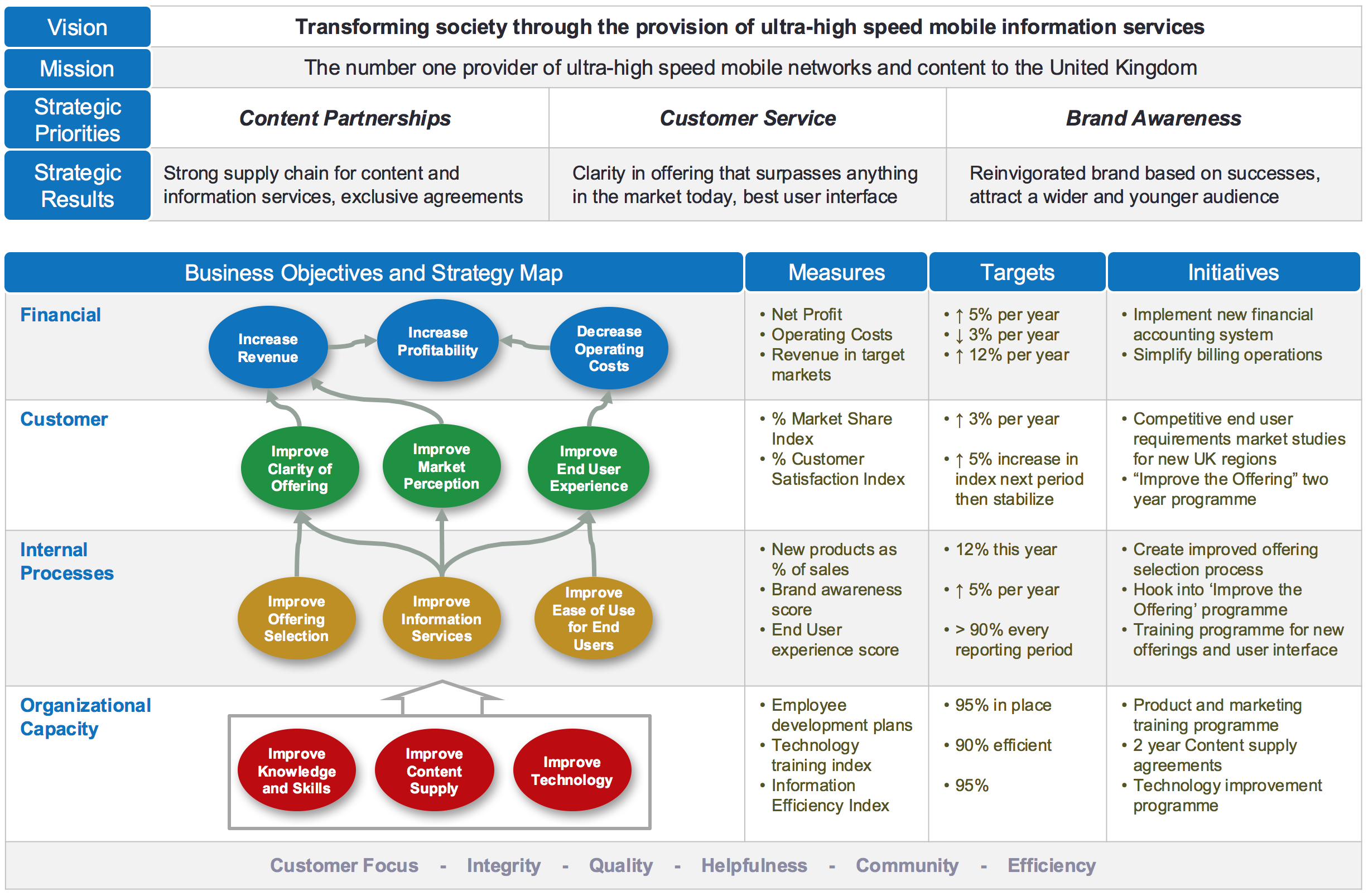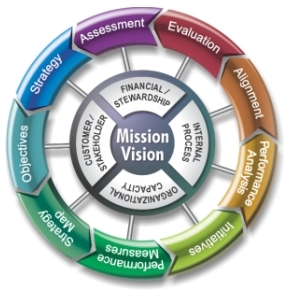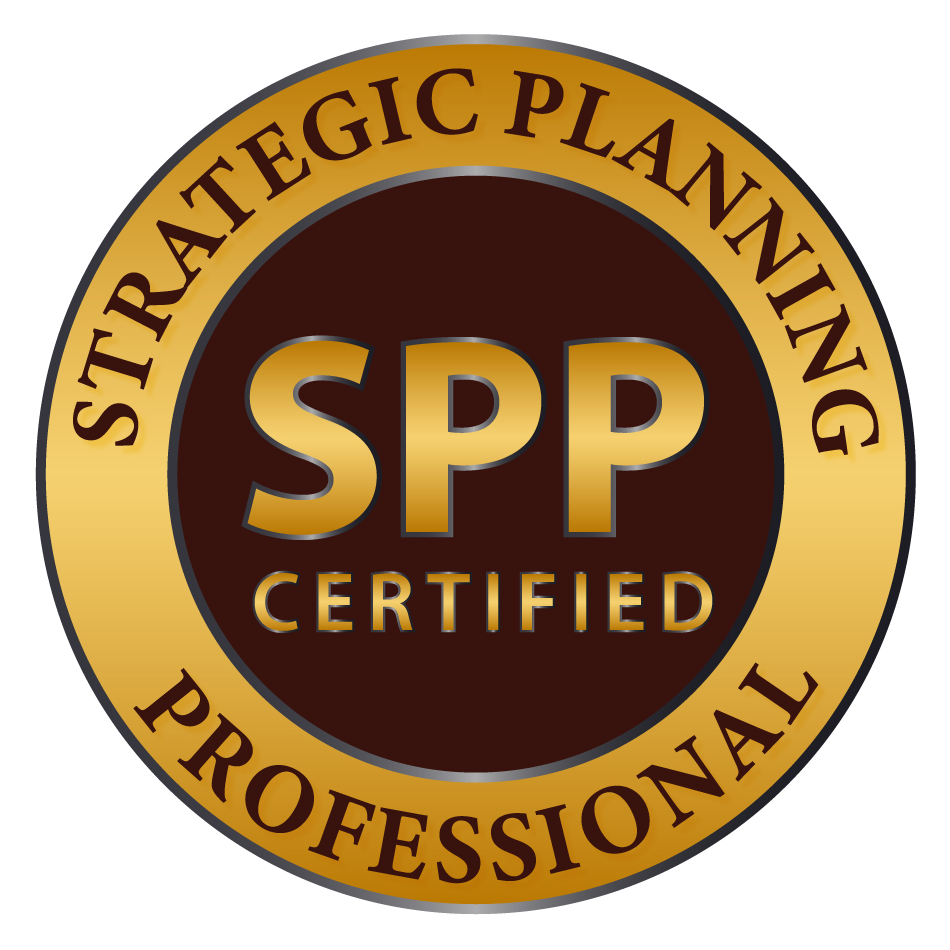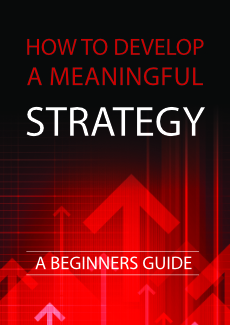Strategic Process
See how a KPI Software package can help
A Strategic Process
Strategy is a process. Developing a strategy for business, not-for-profit or government is to develop a process to guide an organisation to a successful future. Strategy is not an ad-hoc activity and it certainly is not an annual event.
There are many strategic processes available, most of which have been defined by medium to large companies and are used in-house as proprietary methods. There are fewer publically defined strategic processes, most of which are badly defined or lacking in detail. In the previous section, three of the most well-known have been described to illustrate the diversity of approaches.
This section will concentrate on the Balanced Scorecard Strategic Process. There are several reasons to select the Balanced Scorecard above any other approach:
- The Balanced Scorecard has a long track record of success. It has been around for over 20 years.
- The process is maintained and updated by the Balanced Scorecard Institute who hold the de-facto standard for the world.
- It is used by over 50% of the world’s largest companies and countless small to medium sized companies and organisations.
- The process is ‘inclusive’ and encourages the use of strategic tools such as SWOT, PESTLE, Blue Ocean, Strategy Maps and many others.
- There are certification courses available for Balanced Scorecard professionals and masters (BSP and BSMP) endorsed by the George Washington University.
What is the Balanced Scorecard?
The Balanced Scorecard is a strategic planning and management system that aligns an organisation to its vision and goals. It is a step-by-step process that ensures a strategy is kept alive by embedding it into day-to-day organisational activities.
The Balanced Scorecard concerns itself with a small number of financial and non-financial strategic objectives and measures that are directly related to an organisation’s vision and strategic priorities. The ‘balance’ that the Balanced Scorecard achieves is brought about by a focus on four areas that are described as Perspectives.
The four Perspectives are:
- Financial – The high level financial objectives and financial measures of the organisation that help answer the question: How do we look to our shareholders?
- Customer – All objectives and measures that are directly related to the organisation’s customers, focusing on customer satisfaction. To answer the question: How do our customers see us?
- Internal Processes – The objectives and measures that determine how well the organisation is running and whether the products or services conform to what is required by the customers, in other words, what should we be best at?
- Organisational Capacity – The objectives and measures concerning how well our people perform, their skills, training, company culture and leadership. This perspective also includes infrastructure and technology. Answering the question: How can we improve and create value?
The real strength of the Balanced Scorecard approach is the way it connects every part of a strategy. The most significant output of the process is an Integrated Balanced Scorecard Strategy Map:
In the example above, we can see that the objectives, which sit solidly in the middle of the diagram, are linked together from the bottom of the map to the top. There is a causal relationship between investments made in Organisational Capacity and the Financial outcome. This allows us to tell a convincing ‘story’ when we need to describe the overall strategy.
To the right of the Objectives are Measures, Targets and Initiatives. Again, there is intent behind this structure. This in an area where the Balanced Scorecard approach differs from other methodologies. The strategy leads with a Vision, Mission and Objectives. These are measurable and targets can be set. Once this has been done, but not before, Initiatives or Projects will be considered. By leaving the definition of Initiatives to the end of the process, we can be confident we are doing the right things to ensure the success of our strategy.
The Nine Steps
The Balanced Scorecard Institute, who are the keepers of the de-facto standard for the Balanced Scorecard process, have defined a nine-step process that is represented as spoked wheel surrounding a Mission and Vision.
The Nine Steps to Success™, is a disciplined, practical approach to developing a strategic planning and management system based on the balanced scorecard.
In theory, it is possible to enter the wheel at any stage. In practice, it is best to start at the Assessment phase even if it means simply validating any work that has been done to date.
In brief, the nine steps can be described as follows:
Step One: Assessment
Step one of the scorecard building process starts with an assessment of the organisation’s Mission and Vision, challenges (pains), enablers, and values. Step one also includes preparing a change management plan for the organization, and conducting a focused communications workshop to identify key messages, media outlets, timing, and communicators. More about Assessment
Step Two: Strategy
In step two, elements of the organisation’s strategy, including Strategic Results, Strategic Priorities, and Perspectives, are developed by workshop participants to focus attention on customer needs and the organisation’s value proposition. More about Strategy
Step Three: Objectives
In step three, the strategic elements developed in steps one and two are turned into Strategic Objectives, which are the basic building blocks of the strategy. They define the organisation’s strategic intent. Objectives are created referencing Strategic Priorities categorised by Perspective. More about Objectives
Step Four: Strategy Map
In step four, the cause and effect linkages between the Strategic Objectives are formalised in a Strategy Map that shows how the organisation creates value for its customers and stakeholders. More about Strategy Maps
Step Five: Performance Measures
In step five, Performance Measures are developed for each of the Strategic Objectives. Leading and lagging measures are identified, expected targets and thresholds are established, and baseline and benchmarking data is developed. More about Performance Measures
Step Six: Initiatives
In step six, Strategic Initiatives are developed that support the Strategic Objectives. To build accountability throughout the organisation, ownership of Performance Measures and Strategic Initiatives is assigned to the appropriate staff and documented in data definition tables. More about Initiatives
Step Seven: Performance Analysis
In step seven, the implementation process begins by applying performance measurement software to get the right performance information to the right people at the right time. Automation adds structure and discipline to implementing the Balanced Scorecard system. More about Performance Analysis
Step Eight: Alignment
In step eight, the organisation-level scorecard is ‘cascaded’ down into business and support unit scorecards, meaning the organisational level scorecard (the first Tier) is translated into business unit or support unit scorecards (the second Tier) and then later to team and individual scorecards (the third Tier). Cascading translates high-level strategy into lower-level objectives, measures, and operational details. Cascading is the key to organisation alignment around strategy. More about Alignment
Step Nine: Evaluation
In step nine, an Evaluation of the completed scorecard is done. During this evaluation, the organisation tries to answer questions such as, ‘Are our strategies working? Are we measuring the right things? Has our environment changed?’ Are we budgeting our money strategically?’ More about Evaluation
The process is cyclical, however, there are feedback loops throughout every stage. For example, one of the most common feedback areas occurs when developing performance measures. It is often the case that Strategic Objectives are seen to be ‘unrealistic’ when the discipline of measurement is applied. At this point it is good practice to go back from step five to step three and re-think a Strategic Objective and frame it into something that is possible rather than impossible.
Conclusion
Strategy is a process. One of the most successful strategic processes available is the Balanced Scorecard strategic planning and management system. Considering the decades of successful use, the question must be asked, why invent a new untried and untested process to manage our strategy?
Strategic Process
Intrafocus teaches a 7-step strategic process based on the Balanced Scorecard strategic methodoly.
Download the whole guide: What is a Strategy?
Watch the BSC Video





